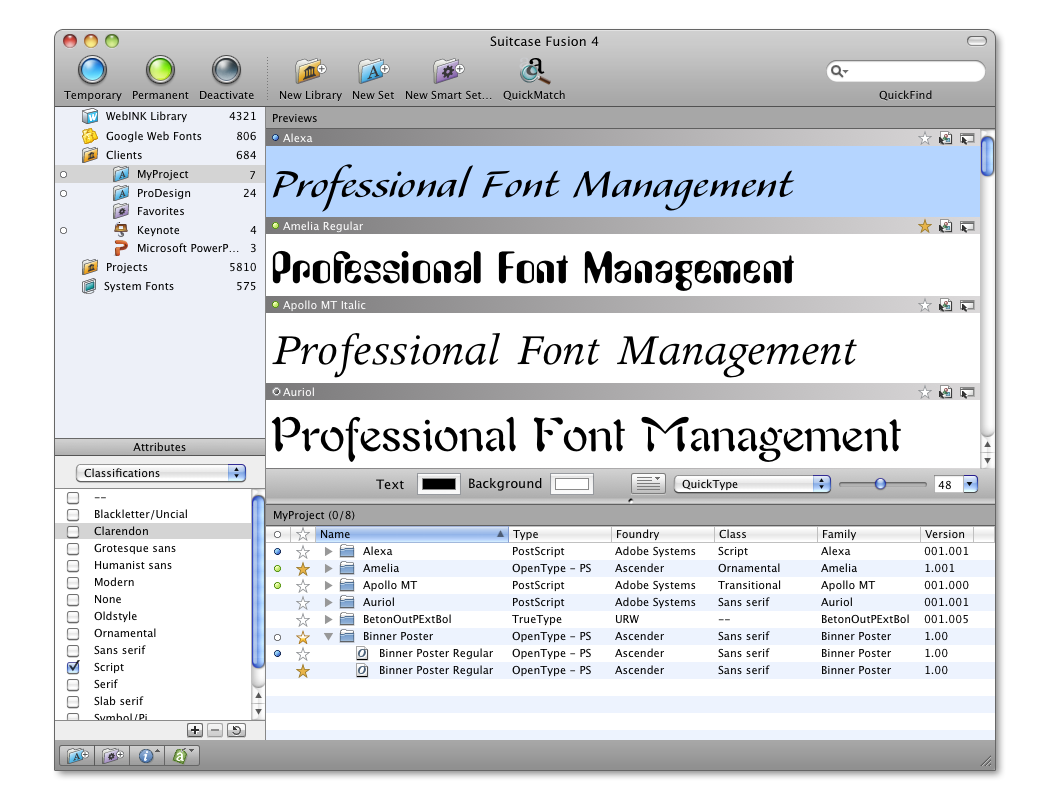Font Management Software Is Available For Mac

Free Font Manager For Mac
Thanks to OS X 10.3’s Font Book, most Mac users don’t need to buy a font management program. But if you have tons of fonts, share a font library with others, or have lots of fonts flowing through your system (from clients or collaborators, for example) you’ll need more features than Font Book offers. This review looks at some popular third-party font-handling tools. There are three main font-management tasks: organizing font libraries (which also makes sharing easier), minimizing the number of active fonts in your System folder (shortening font menus and reducing computing overhead), and assuring that your fonts function properly (checking for corruption and duplicates). No one program does it all perfectly.
FontDoctor 7.0 Fonts break, and when they break, systems crash. Missing screen or printer fonts and identically named fonts in different formats confuse applications and printers, causing program crashes and surprise printing results. The solution? Call the FontDoctor.
FontDoctor 7 can organize fonts into tidy libraries (by either copying them or moving them), archive fonts into a single compressed file for safe keeping, and convert TrueType fonts between Mac and Windows formats. But the main reason you will want it is to fix corrupted font files, sort out duplicate fonts (or those with duplicate names), and weed out PostScript printer and screen fonts that have lost their partners. You can also sort duplicate fonts by their ages, saving only the newest ones. Although FontDoctor can weed out sick fonts, it can’t always tell you how serious their maladies are, and its manual admits that some fonts that it pulls aside as suspicious (due to unusual programming) may, in fact, work just fine. FontDoctor searches any folder, disk, or mounted volume for fonts in PostScript Type 1, TrueType (Mac, Windows.ttf, and.dfonts), or OpenType format. After scanning them for problems or missing parts, it will fix the fixable and organize them into a neat library. The program also lets you organize your fonts into a series of folders best suited to your workflow.
Fonts you don’t want, irreparable fonts, or fragments of fonts (or those that simply don’t correspond to orthodox font programming norms) can be isolated or sent to the Trash. Well-designed, easy to use, and clearly documented, FontDoctor is cheap insurance against misbehaving fonts, which are devils to identify and impossible to fix without a specialized tool. Although well-organized users may not think they need a font management program, there’s no substitute for a font-repair kit, and FontDoctor 7 is good one. Extensis Suitcase owners already know this, as FontDoctor has been bundled with Suitcase for several years. FontAgent Pro 3.0 Insider Software has paid attention to its competition, and rolled many of the best aspects of existing font-management programs into FontAgent Pro 3, making it a leading contender.
FontAgent Pro scans your Mac and any connected devices, disks, or volumes, and gathers your fonts—either by copying or moving them—into a new library organized by font family; the exceptions are the few system fonts OS X needs to do its business. You can then organize the fonts into sets for batch activation and deactivation. You also can create multiple libraries with overlapping contents to simplify access to huge font collections. One of FontAgent Pro’s hallmarks is automatic font activation. Open a document that has a disabled font, and FontAgent Pro will activate that font. For popular applications that don’t support auto-activation (such as Adobe InDesign, Illustrator, and Photoshop, and QuarkXPress), FontAgent Pro features plug-ins that will do the trick.

A useful complement would be automatic activation when you close such a document, but FontAgent Pro does not offer it. FontAgent Pro borrows a couple of OS X’s font-management tools. For example, its Show Fonts command opens OS X’s Fonts Palette, which is useful for revealing the features of individual (especially OpenType) fonts through its Typography option. However FontAgent Pro doesn’t control which fonts are displayed in the OS X Fonts panel; whether they’re activated or not, if OS X can find them, it will list them. While FontAgent Pro 3 does not offer any powerful diagnostic tools for analyzing what’s wrong with a font rather than just flagging it as suspicious, it will scan fonts before activation to assure they’re complete and uncorrupted. You can filter any problem fonts out of your library.
This is probably all the doctoring most Mac users will ever need. Master Juggler 3.0.3 Time has passed Alsoft’s MasterJuggler by, and it’s in serious need of an upgrade.
It can’t, for example, go out and search your system for available fonts. You have to point it to where all your fonts are stored before it adds them to its library.
From there you can gather them into the familiar sets that allow you to activate and deactivate fonts in batches. It also can’t distinguish between the fonts in any Library/Fonts folder that are truly required by the System (just a small handful), and those that have been put there for all System users to share. It considers them all to be untouchable System fonts. If you want to activate or deactivate these fonts or build them into sets, you’ll have to move them elsewhere first, which is unnecessarily tedious. MasterJuggler does check fonts for problems, but it doesn’t solve them. It just flags them and leaves you to do the fixing.

If you have missing screen fonts, you’ll have to fix them. If you have a corrupted font file, you’ll have to isolate it. If you have duplicate fonts or multiple versions of the same font, you’ll have to take care of the problem. MasterJuggler 3 adds a font viewer for seeing individual characters contained within a font, but it’s not well thought out. There’s no single view of the entire character set of a font; to find the character you’re after, you have to know in which Unicode numbering range it’s hidden. This can be far from obvious. You can also drag any character from the viewer into any text-editing application, but you first have to match the point size in the viewer to that of the text, or it comes in at the wrong size.
Font Manager For Mac
I thought MasterJuggler 2 was best-of-breed when it came out a decade ago, but version 3 has fallen behind the competition. If Alsoft wants to stay in the race, MasterJuggler will need automatic font collection, automatic font activation, and a more useful way to access the character sets of large OpenType fonts just to stay even. Macworld’s Buying Advice If you’re having problems with corrupt font files, duplicate fonts, and mismatched PostScript printer and screen fonts, FontDoctor 7 is the best remedy. While it sometimes mistakenly flags functional fonts, it will most often repair your fonts and organize them into a neat library. However, if you’re looking for a font manager that scours your hard drive for fonts, gathers them into alphabetical folders and auto activates them by project, I recommend FontAgent Pro 3.
An added bonus is that the program will scan fonts before activating them to make sure they’re complete and uncorrupted. James Felici has been using the Mac for over 20 years and was a member of the Macworld start-up team. His latest book is The Complete Manual of Typography (Adobe Press, 2002). For more reviews about font managers, please see our review of Suitcase X1 (; ).
Manage your font suitcases and printer fonts in 'Sets', like Extensions Manager! Fonts Manager is similar to the Mac OS Extensions Manager, but it manages Fonts instead. It allows the enabling and disabling of font suitcases and printer fonts in 'Sets', so you shrink those long Font menus. It allows you to view, print, and save font samples. Open and save 'Sets' files for limitless set configuration and easy upgrade from previous versions. Balloon Help is available everywhere and all of this documentation is available from within the application. Full Specifications What's new in version 3.9.3 Mac OS 9.1 and later support 512 suitcases instead of just 128.
Font Management Software Is Available For Mac Free
General Publisher Publisher web site Release Date September 14, 2002 Date Added September 14, 2002 Version 3.9.3 Category Category Subcategory Operating Systems Operating Systems Mac/OS Classic Additional Requirements. System 7.1 or higher Download Information File Size 369.09KB File Name fm-393.bin Popularity Total Downloads 97,315 Downloads Last Week 1 Pricing License Model Free to try Limitations Not available Price $49.